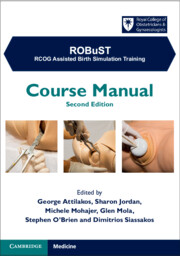342 results
Contents
-
- Book:
- ROBuST: RCOG Assisted Birth Simulation Training
- Published online:
- 06 June 2024
- Print publication:
- 20 June 2024, pp v-v
-
- Chapter
- Export citation
Copyright page
-
- Book:
- ROBuST: RCOG Assisted Birth Simulation Training
- Published online:
- 06 June 2024
- Print publication:
- 20 June 2024, pp iv-iv
-
- Chapter
- Export citation
Contributors
-
- Book:
- ROBuST: RCOG Assisted Birth Simulation Training
- Published online:
- 06 June 2024
- Print publication:
- 20 June 2024, pp vi-viii
-
- Chapter
- Export citation
Reviews
-
- Book:
- ROBuST: RCOG Assisted Birth Simulation Training
- Published online:
- 06 June 2024
- Print publication:
- 20 June 2024, pp ii-ii
-
- Chapter
- Export citation
Preface
-
- Book:
- ROBuST: RCOG Assisted Birth Simulation Training
- Published online:
- 06 June 2024
- Print publication:
- 20 June 2024, pp ix-ix
-
- Chapter
- Export citation
Chapter 1 - Trends in Assisted Vaginal Birth and Future Practice
-
-
- Book:
- ROBuST: RCOG Assisted Birth Simulation Training
- Published online:
- 06 June 2024
- Print publication:
- 20 June 2024, pp 1-9
-
- Chapter
- Export citation
Acknowledgements
-
- Book:
- ROBuST: RCOG Assisted Birth Simulation Training
- Published online:
- 06 June 2024
- Print publication:
- 20 June 2024, pp x-x
-
- Chapter
- Export citation
Index
-
- Book:
- ROBuST: RCOG Assisted Birth Simulation Training
- Published online:
- 06 June 2024
- Print publication:
- 20 June 2024, pp 142-152
-
- Chapter
- Export citation
Abbreviations
-
- Book:
- ROBuST: RCOG Assisted Birth Simulation Training
- Published online:
- 06 June 2024
- Print publication:
- 20 June 2024, pp xi-xii
-
- Chapter
- Export citation
Chapter 8 - Psychopharmacology of Chronic Aggression and Violence in Forensic Settings
-
-
- Book:
- Seminars in Forensic Psychiatry
- Published online:
- 06 June 2024
- Print publication:
- 13 June 2024, pp 208-228
-
- Chapter
- Export citation

ROBuST: RCOG Assisted Birth Simulation Training
- Course Manual
-
- Published online:
- 06 June 2024
- Print publication:
- 20 June 2024
Nomenclature of the Micas
-
- Journal:
- Clays and Clay Minerals / Volume 46 / Issue 5 / October 1998
- Published online by Cambridge University Press:
- 28 February 2024, pp. 586-595
-
- Article
- Export citation
Burial and subsequent growth of rigid ryegrass (Lolium rigidum) and ripgut brome (Bromus diandrus) following strategic deep tillage
-
- Journal:
- Weed Science / Volume 72 / Issue 3 / May 2024
- Published online by Cambridge University Press:
- 20 February 2024, pp. 257-266
-
- Article
-
- You have access
- Open access
- HTML
- Export citation
A theory of plural constituent power for federal systems
-
- Journal:
- Global Constitutionalism , First View
- Published online by Cambridge University Press:
- 19 January 2024, pp. 1-21
-
- Article
-
- You have access
- Open access
- HTML
- Export citation
32 Prediction of Seizure Outcome with Presurgical IAT, MRI, and PET in Patients with Temporal Lobe Epilepsy Undergoing Surgery
-
- Journal:
- Journal of the International Neuropsychological Society / Volume 29 / Issue s1 / November 2023
- Published online by Cambridge University Press:
- 21 December 2023, pp. 31-32
-
- Article
-
- You have access
- Export citation
39 - Guanfacine
-
- Book:
- Cambridge Prescriber's Guide in Psychiatry
- Published online:
- 20 December 2023
- Print publication:
- 16 November 2023, pp 269-274
-
- Chapter
- Export citation
66 - Nortriptyline
-
- Book:
- Cambridge Prescriber's Guide in Psychiatry
- Published online:
- 20 December 2023
- Print publication:
- 16 November 2023, pp 451-458
-
- Chapter
- Export citation
28 - Doxepin
-
- Book:
- Cambridge Prescriber's Guide in Psychiatry
- Published online:
- 20 December 2023
- Print publication:
- 16 November 2023, pp 193-200
-
- Chapter
- Export citation
91 - Trihexyphenidyl hydrochloride
-
- Book:
- Cambridge Prescriber's Guide in Psychiatry
- Published online:
- 20 December 2023
- Print publication:
- 16 November 2023, pp 635-638
-
- Chapter
- Export citation
44 - Isocarboxazid
-
- Book:
- Cambridge Prescriber's Guide in Psychiatry
- Published online:
- 20 December 2023
- Print publication:
- 16 November 2023, pp 307-312
-
- Chapter
- Export citation

